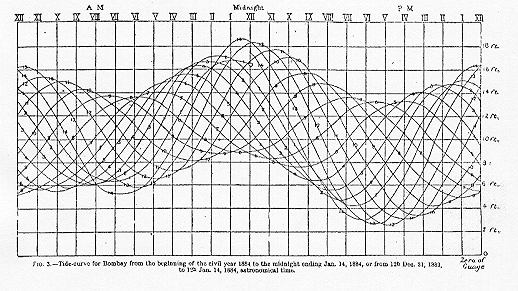
| A two-week tidal record: January 1-14 1884 at Bombay. From Sir George Herbert Darwin's article Tides, in Encyclopaedia Britannica, IX Ed., R. S. Peale & Co. Chicago 1890 Vol. XXIII pp. 353-381 |
 Fourier Analysis of Ocean Tides II
Fourier Analysis of Ocean Tides II
Web resources on Fourier Series are disappointing. Synthesis is
emphasized over analysis: lots of demos of
the square wave, not much elementary
explanation of the calculation of coefficients.
There is a nice
presentation on sine series by
Key Curriculum Press, on the Swarthmore site. There is a complete
presentation, but at the advanced undergraduate level, as part of
Linear Methods of Applied Mathematics by
Evans M. Harrell II and James V. Herod.
Besides Kelvin's own writings,
a reference for his work in developing mechanical devices is
George Green and John T. Lloyd, Kelvin's Instruments and the Kelvin Museum, University of Glascow, 1970. My main reference on tidal theory and analysis
is Paul Schureman, Manual of Harmonic Analysis and Prediction of
Tides, United States Government Printing Office 1958.

| A two-week tidal record: January 1-14 1884 at Bombay. From Sir George Herbert Darwin's article Tides, in Encyclopaedia Britannica, IX Ed., R. S. Peale & Co. Chicago 1890 Vol. XXIII pp. 353-381 |
The task of tidal analysis is to take a limited sample of the tidal record, such as the two weeks readings from a tidal gauge at Bombay, and use it to predict the tides at that port in the future. In fact, for a complete calculation, a 369-day sample is the standard. The method used is harmonic analysis. Ordinarily, harmonic analysis is used for periodic functions, functions which repeat themselves exactly after a certain interval of time. But the tidal record is not periodic.
What we know from the geometry
of the Sun-Earth-Moon system is that the
tide-generating force at any point on the Earth's surface
is a linear combination of sines and cosines whose
frequencies come from a specific set:
certain linear combinations, with small integral coefficients,
of the fundamental astronomical frequencies governing
the system. It is natural to suppose that the height of
the tide, at Bombay for example, should also be a linear combination
involving the same frequencies.
The number of these frequencies produced by a detailed analysis
is quite large. Schureman lists some 37 different frequencies
for the solar tide, and some 88 for the lunar.
In practice only about 37 in all are ever used, and most ports use around 25, so the height of the tide can be written as
where the subscripts 1, 2, ... run up to about 25, the ``speeds'' vk are known a priori and the coefficients A0, A1, B1, etc, depend on the port. For example, here are the ten speeds (in degrees per hour) which figure most importantly in the tides of a port like Bridgeport, Connecticut:
| 2T-2s+2h | 2T-3s+2h+p | 2T | T+h | 2T-s+2h-p |
| T-2s+h | h | 2T-3s+4h-p | 2T-2h | s-p |
| (T = 15.00 | s = 0.549... | h = 0.041... | p = 0.0046...) |
This column will examine how Fourier analysis can be adapted to calculate, from the tidal record at a port, the coefficients A0, A1, B1, etc. Then the record may be extrapolated into the future, and tides for that port may be accurately predicted.
--Tony Phillips
Stony Brook
|
|
|
© Copyright 2001, American Mathematical Society |